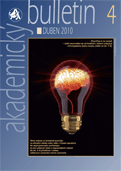
New knowledge from virologists from the Academy of Sciences of the CR
Endogenetic retroviruses, which attacked our ancestors millions of years ago and became components of human DNA, which thanks to evolution do not evoke infections in our organisms but some of their genes, on the other hand, benefit us, because they are models of the synthesis of several proteins enriching cells by a new essential function. Nevertheless, in ‘the wrong places’, this at other times welcome life-giving ability can work counterproductively and threaten our health. A team of virologists led by Dr Jiří Hejnar from the Institute of Molecular Genetics of the ASCR has described the mechanisms regulating these processes.
The mentioned proteins include also syncytin-1 and -2, originally retroviral envelope
glycoproteins, which had the task of fusing viral particles with the host cell. Both syncytins are
found on the surface of specialised cells of the placenta and through their activity force these
cells to fuse. In the area of contact with uterine mucous membrane, a layer of fused cells thus
emerges, which is entirely essential for the correct exchange of nutrients and gases between the
blood circulation of the mother and foetus. We can see a reduced amount of syncytin-1 in the cells
of the placenta with severe complications of pregnancy (so-called preeclampsia) caused by the poor
supply of the foetus with oxygen and nutrients. Whereas in the placenta, the presence of syncytins
is necessary, in other tissues these proteins are not desirable and the fusion of cells outside of
the placenta could lead to disorders. The presence of syncytin-1 has for instance been proved in
the brain of patients with multiple sclerosis. It is clear that the organism must very strictly
regulate the production of syncytins.
But how does such regulation take place? Information from genetic deoxyribonucleic acid (DNA)
is in the process called transcription transferred to ribonucleic acid (RNA), which is subsequently
modified (spliced) and then used as a model for the production of the relevant protein, in our case
syncytin. The scientific team of Dr Hejnar has shown that the regulation of the genes for syncytins
lies in the chemical modifications (DNA methylation, histone methylation) governing parts of the
genes. These modifications prevent the transcription of the genes to RNA, and hence also the
subsequent synthesis of syncytin.
The second level of the regulation is splicing, which correctly functions only in the
placenta. Unspliced molecules of RNA, if despite the first barrier were to emerge in cells outside
of the placenta, could not be used for the production of syncytins. In this connection, an
important role is played also by the finding that syncytin RNA is successfully transcribed also
spliced in tumours of the embryonic lines (seminomas, choriocarcinomas, mixed germinal carcinomas).
Deregulation of syncytin-1 here can thus enhance the malignant potential of tumours.
‘The results described contribute to a better understanding of tissue-specific regulation of
syncytins. The new knowledge of the regulation of these proteins could be utilised to classify
tumours more precisely like in the diagnostics, prevention or treatment of disorders of the
placenta, which remain a serious complication of pregnancy even in developed countries. On the
theoretical level, it is a graphic example of a process in which originally viral genes are adapted
to a new cellular function. A similar process took place in the history of mammals independently in
all of developmental lines with a perfect type of placenta, like primates, rodents and beasts of
prey. Evolution continues to amaze us with how it manages to work even with genetic waste coming
dangerous parasites,’ explains Dr Jiří Hejnar.

Cells in a culture, which (centre of the field of vision) floating in multinucleated syncytium
under the influence of syncytin-1
You can find more information in the publication:
Trejbalová K., Blažková J., Matoušková M., Kučerová D., Pecnová L., Vernerová Z., Heráček J.,
Hirsch I., Hejnar J.
Epigenetic regulation of transcription and splicing of syncytins, fusogenic glycoproteins of
retroviral origin. Nucleic Acids Research 2011 39(20):8728-39.
contact: Jiří Hejnar, Ph.D. , Institute of Molecular Genetics of the ASCR, v. v. i.; tel:
241 063 443, email:
jiri.hejnar@img.cas.cz;
http://www.img.cas.cz/cvg
Prepared by: Department of Media Communication of the Head Office of the ASCR and Institute of
Molecular Genetics of the ASCR
29 Feb 2012




